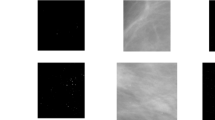Abstract
The shape and arrangement of clustered microcalcifications help the radiologists to judge the likelihood of cancer being present. In general, malignant calcifications are very numerous, clustered, small, dot-like or elongated, and variable in size, shape, and density. In contrast, benign calcifications are generally larger, less numerous, more rounded, more diffusely distributed, and more homogeneous in size and shape. Starting from a segmentation algorithm that individually identifies the microcalcifications, we have used a bottom-up hierarchical algorithm to group them into clusters for a later characterization. This behavior leads to meaningfully differentiated shapes for both kinds of clusters. A Case-Based Reasoning classifier has been applied to classify the data and validate the cluster composition with promising results (at a false positive fraction of 10%, an 86% true positive fraction has been attained).
Access this chapter
Tax calculation will be finalised at checkout
Purchases are for personal use only
Similar content being viewed by others
References
Martí J, Cufi X, Regincós J, et al. Shaped-base features selection for microcalcification evaluation. In Kenneth M. Hanson ed., Medical Imaging 1998, SPIE vol. 3338, pages 1215–1224. February 1998.
Woods K, Automated Image Analysis Techniques for Digital Mammography Ph.D. Dissertation, December 1994. University of South Florida.
Shen L, Rangayyan RM, Leo Desautels JE. Detection and Classification of mammographic Calcifications, World Scientific, State of the Art in Digital mammographic Image Analysis, volume 9, pages 198–212, June 1994.
Kass M, Witkin A, Terzopoulos D. Snake: Active Contour Models, International Journal of Computer Vision, Kluwer Academic Publishers, 1 (4): 321–331, 1987.
Shen L, Rangayyan RM, Leo Desautels JE. Application of Shape Analysis to mammographic Calcifications. IEEE Transactions on Medical Imaging, vol. 13, no 2 pages 263–274, June 1994.
Marti J, Español J, Golobardes E, et al. Classification of Microcalcifications in Digital Mammograms using Case-Based Reasoning. Proceedings of the 5th International Workshop on Digital Mammography, pages 285–294. Toronto, Canada, June 2000.
Author information
Authors and Affiliations
Editor information
Editors and Affiliations
Rights and permissions
Copyright information
© 2003 Springer-Verlag Berlin Heidelberg
About this paper
Cite this paper
Planiol, P., Martí, J., Español, J., Golobardes, E., Gay, J., Freixenet, J. (2003). Representing clustered microcalcifications by their cluster shape. In: Peitgen, HO. (eds) Digital Mammography. Springer, Berlin, Heidelberg. https://doi.org/10.1007/978-3-642-59327-7_57
Download citation
DOI: https://doi.org/10.1007/978-3-642-59327-7_57
Publisher Name: Springer, Berlin, Heidelberg
Print ISBN: 978-3-642-63936-4
Online ISBN: 978-3-642-59327-7
eBook Packages: Springer Book Archive




